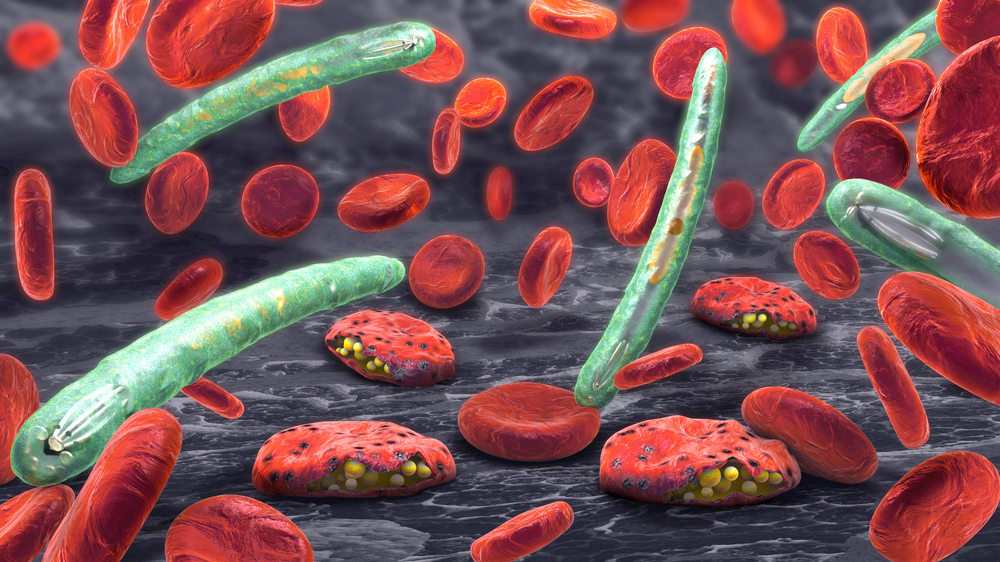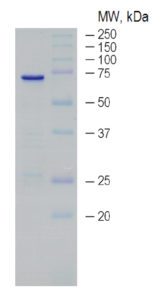SDS-PAGE: Protein was analysed in 12.5% SDS-PAGE with Coomassie blue staining.
Plasmodium Falciparum HRP-II Protein
Price range: $439.34 through $1,318.00 excl. VAT
This product is a recombinant HRP-II protein expressed and purified from E. coli with greater than 95% purity and can be used for developing ELISA and rapid test assays.
PLASMODIUM FALCIPARUM HRP-II PROTEIN
Plasmodium falciparum HRP-II Protein, is a recombinant HRP-II protein expressed and purified from E. coli. The Histidine-rich protein II (HRPII) is an essential P. falciparum protein and it is expressed during the intra-erythrocytic stages of the parasitic life cycle. Since HRPII is expressed only by P. falciparum, it can be used as a marker to distinguish between a P. falciparum malaria infection and infection with one of the other four non-falciparum species.
PRODUCT DETAILS – PLASMODIUM FALCIPARUM HRP-II PROTEIN
- Full-length Pf-HRPII antigen (strain Itg2, NCBI Accession Number: U69551.1).
- Expressed in E. coli and purified by affinity chromatography. Migrates at ~60 kDa on SDS-PAGE and pI is 6.38.
- Presented in 10 mM Tris-HCl, pH 8.5, 10 mM NaCl.
- Can be used for immunoassay development.
BACKGROUND
Plasmodium falciparum is a unicellular protozoan parasite of humans, and causes the most dangerous form of malaria, with the highest rate of complications and mortality in humans. It is transmitted through the bite of female Anopheles mosquitos and is responsible for ~50% of all malaria cases worldwide. As a result, P. falciparum is regarded as the deadliest parasite in humans, causing 435,000 deaths in 2017 alone (WHO).
Histidine-rich protein II (HRPII) is exclusively produced by the falciparum species of Plasmodium and is essential during the intra-erythrocytic stages of its parasitic life cycle. HRPII is so-called because 37% of its amino acid sequence comprises histidine residues (Pal et al., 2016). HRPII is exported by the parasite into the erythrocyte cytosol, where it is then released into the bloodstream upon cell lysis. Here it is thought to circulate act as a virulence factor by compromising the endothelial barrier integrity of the CNS and cause cerebral malaria (idib). Since HRPII is expressed only by the falciparum species and accumulates to high levels in the bloodstream, it can be used as a marker to distinguish between a P. falciparum malaria infection and infection with one of the other four non-falciparum species (Pal et al., 2017).
REFERENCES
- Pal, P., Balaban, A., Diamond, M., Sinnis, P., Klein, R., Goldberg, D. (2017). Plasmodium falciparum histidine-rich protein II causes vascular leakage and exacerbates experimental cerebral malaria in mice. PLoS One. 12(5).
- Pal, P., Daniels, B., Oskman, A., Diamond, M., Klein, R., Goldberg, D. (2016). Plasmodium falciparum Histidine-Rich Protein II Compromises Brain Endothelial Barriers and May Promote Cerebral Malaria Pathogenesis. American Society for Microbiology.
- World Health Organization. (2018). World Malaria Report 2018.


